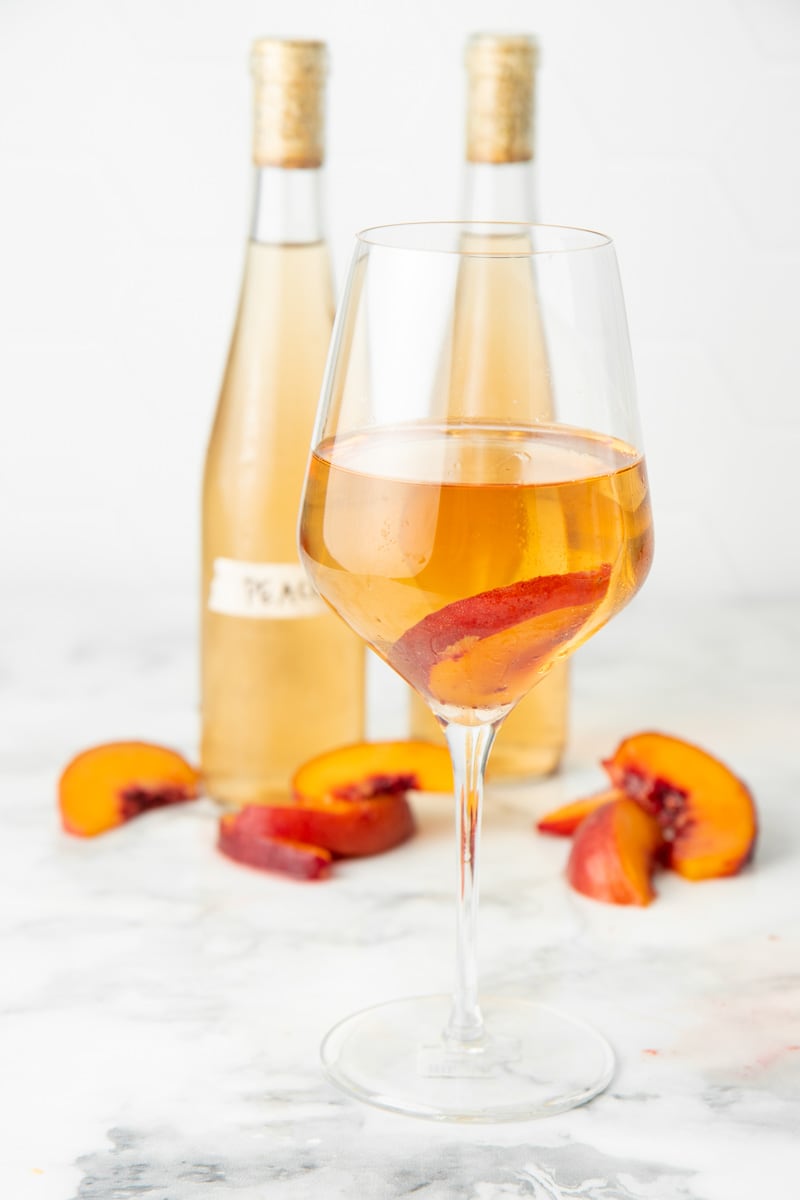Sweet, tender peaches are one of the summer’s greatest gifts. When you have a windfall of peaches, make sure to set aside some to make a batch of peach wine!
Peach wine is one of our favorite country wines to enjoy—it tastes like summer in a bottle, and it’s perfect when chilled and served with a cheese board on a toasty summer evening. If you’re new to making your own homemade wine, no worries! We’ll take you through the process step-by-step, and you’ll be making your own peach wine in no time. Let’s get brewing!
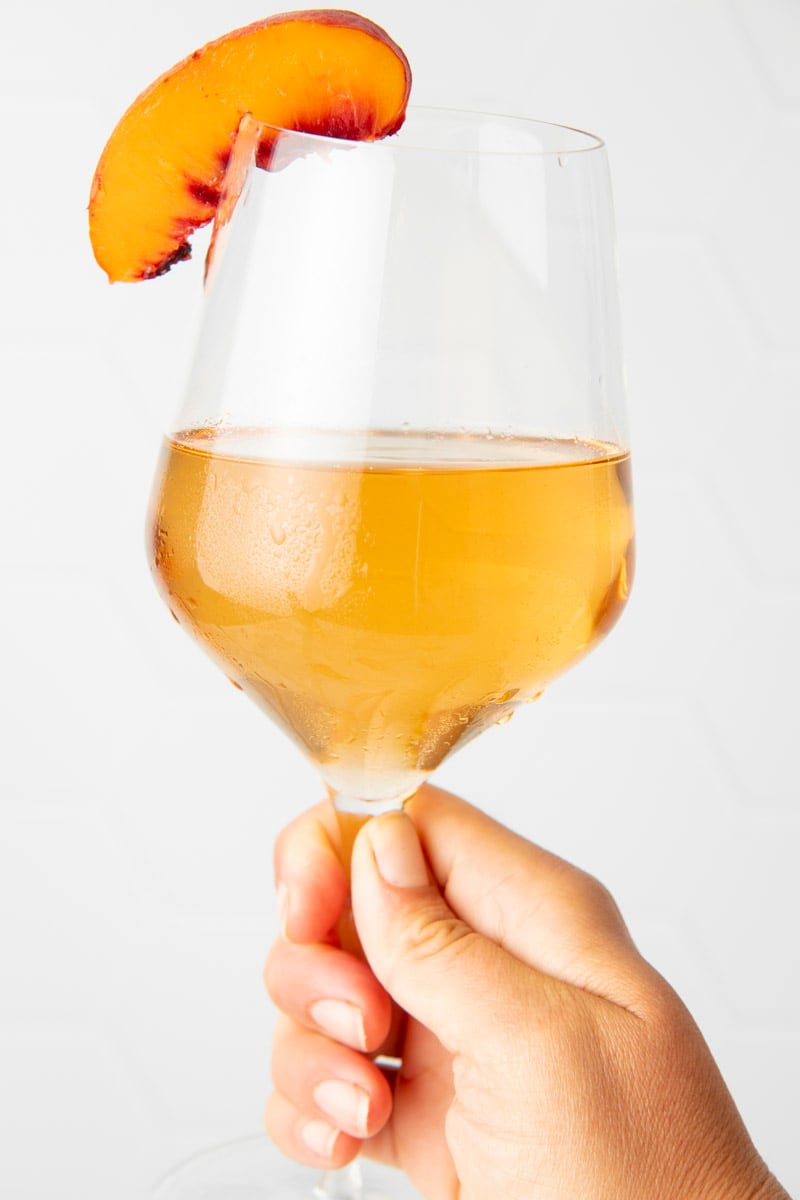
Is peach wine sweet?
The magic of making your own wine is that you can completely customize it to make it what you want! We’ll teach you how to make a dry, semi-dry, semi-sweet, and sweet peach wine—all from the same recipe!
What color is peach wine?
The color of your final wine will depend highly on the blush of the peach skins on your batch of peaches. If your peaches have a lot of red on them, you’ll get a coral or even pink wine. If your peach skins are very orange or pale yellow, your wine will be closer to the yellow spectrum.
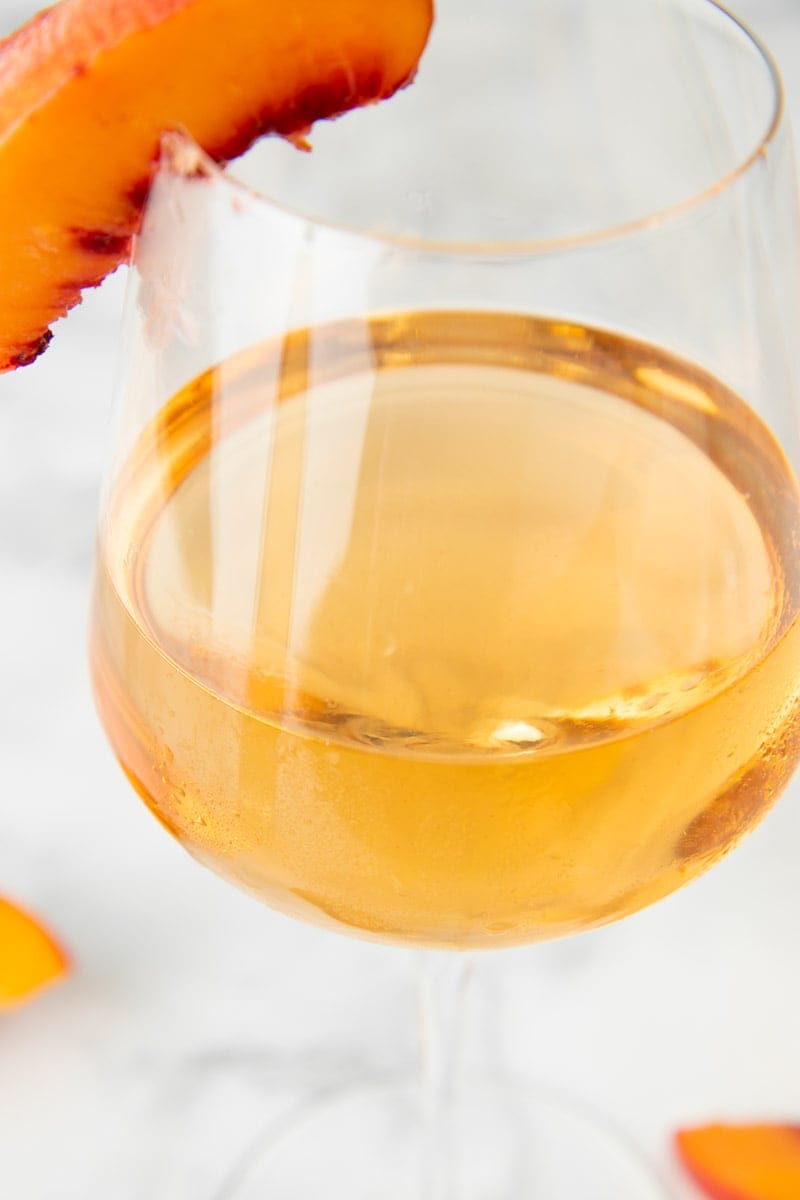
What equipment do I need for making peach wine?
I recommend the following winemaking supplies for beginners. While you can definitely get fancier than this, these are all the bare minimum tools you will need for peach wine, and should come out to a total cost of under $60.
A primary fermentation container:
While we use a fermenter designed for wine, you can also use a big bucket, larger jar, or crock. You need to make sure the container is 40% larger than the amount of wine you want to end up with. This may seem too big, but you need the extra space for three reasons:
- The fresh fruit in the primary fermentation will take up a lot of room.
- The yeast needs space to get all bubbly.
- Extra space = extra oxygen for the yeast to work with.
The peach wine recipe below is for 1 gallon of wine, so you’ll want a container that is at least 1.4 gallons large.
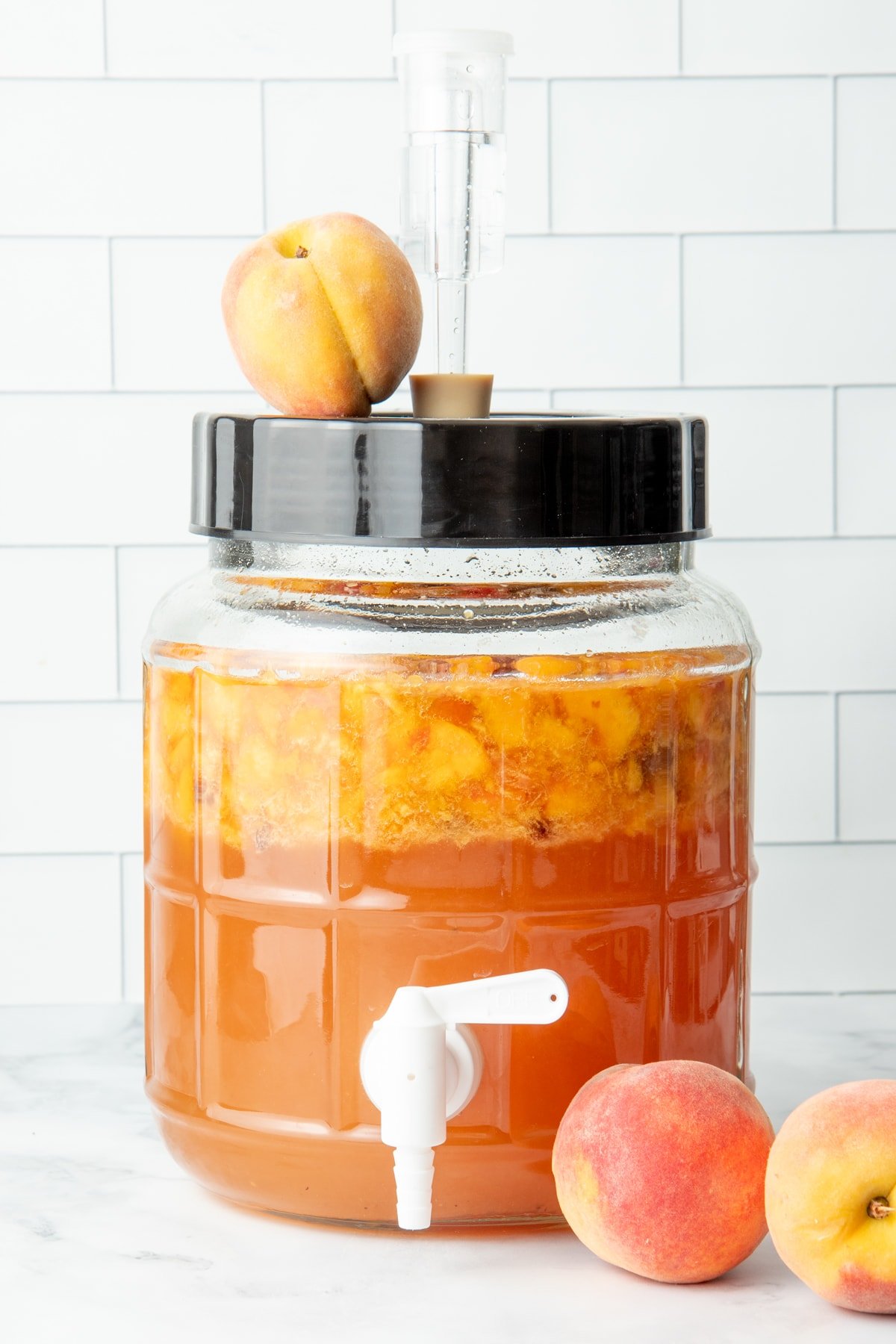
A carboy for secondary fermentation
This is just a fancy word for a big glass jug! We buy one gallon carboys in a bundle with an airlock and cork, but you can also buy them in larger sizes if you plan to make larger batches of wine. Whichever size you choose, make sure your carboy has a narrow neck—having less surface area of the wine exposed to oxygen is a good thing!
An airlock:
Okay, this one isn’t technically necessary, but they are less than $3 and they make winemaking so much easier. The airlock releases the carbon dioxide from fermentation without letting oxygen or anything else into your wine. We go into more detail on the types of airlocks in our fruit wines post.
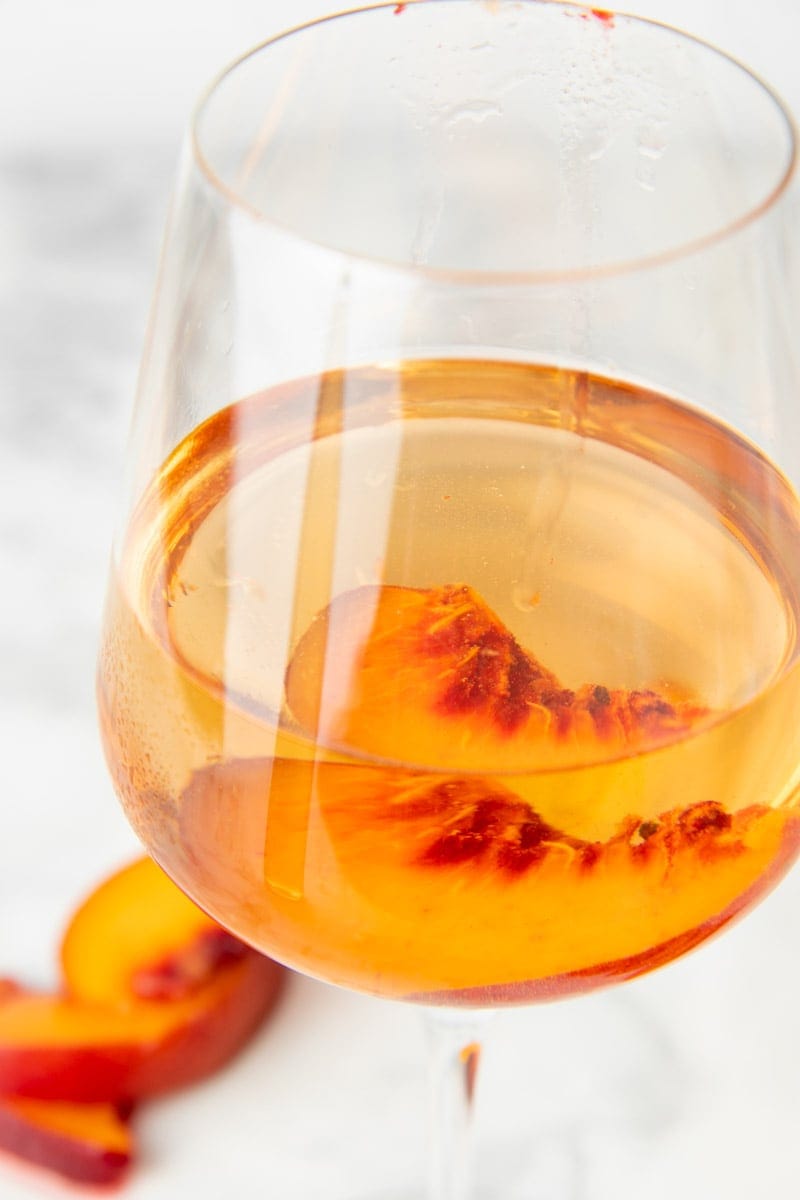
Bottling equipment:
How you bottle your finished wine is up to you! We like flip-top glass bottles because they are easy and adorable, but you can also use new or recycled wine bottles and a corker, or even glass mason jars.
A siphon/bottle filler will make it much easier to rack, or transfer/bottle, your wine— it is an efficient way to transfer wine from one container to another without disturbing the sediment.
You’ll also want a container with a spigot that you can use to bottle from. You can buy a special bottling bucket, but we just use our primary fermenter.
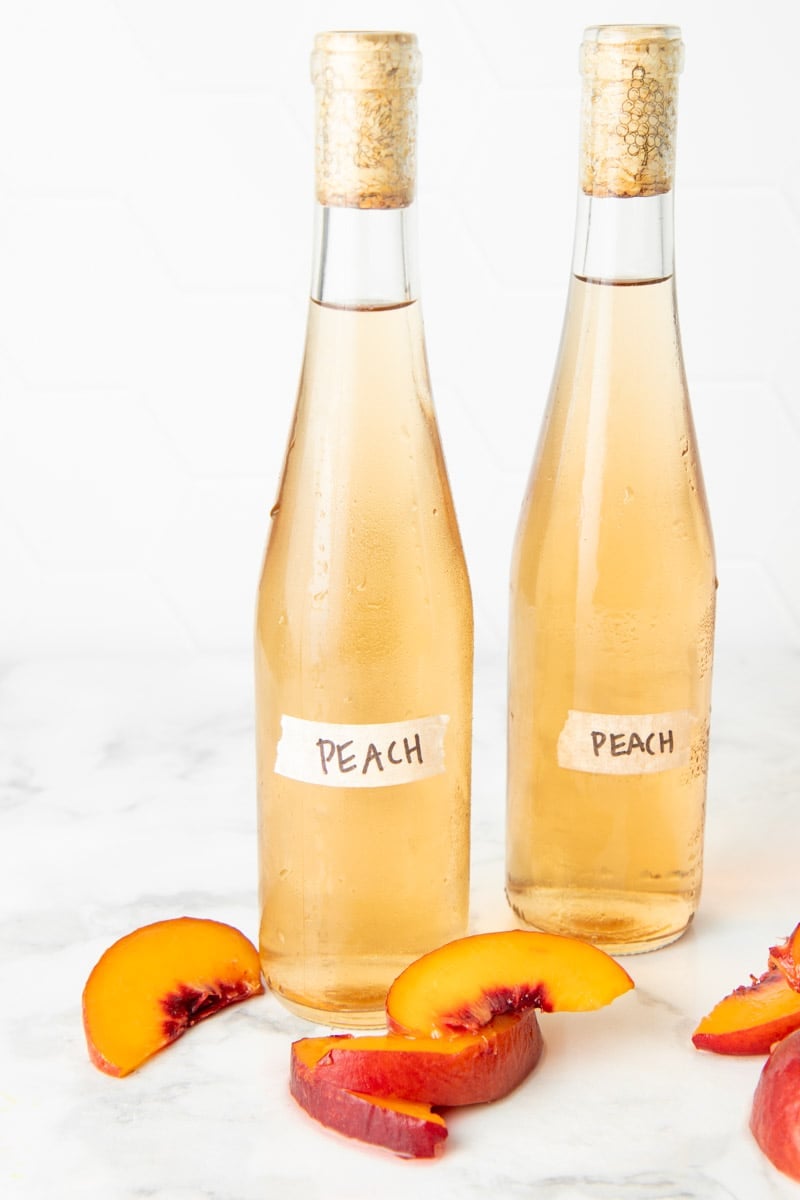
Standard Kitchen Equipment
Everything else you’ll need are things you probably already have in your kitchen, like spoons, funnels, and sieves. Ready with your equipment? Let’s talk ingredients!
What ingredients do I need for peach wine?
You’ll only need a handful of ingredients for peach wine. Let’s get into them!
Peaches (obviously!)
We recommend finding fresh, in-season peaches, pitting them, slicing or roughly chopping them, and then freezing them. Freezing the peaches breaks down their cell structure so that they release their juices more easily come wine time.
Wholefully Protip
Keep those skins on the peaches! They add a beautiful hue to your finished wine.
Sugar
You’re going to need a lot of organic cane sugar here. Never fear, dry wine lovers—most of that sugar is going to feed the yeast and will be turned into alcohol, so adding lots of sugar doesn’t necessarily mean you’ll end up with a sweet wine.
If you want to use another sweetener, you can, but it won’t be wine anymore, and it will change the process a bit. So today, we’re sticking with white sugar.
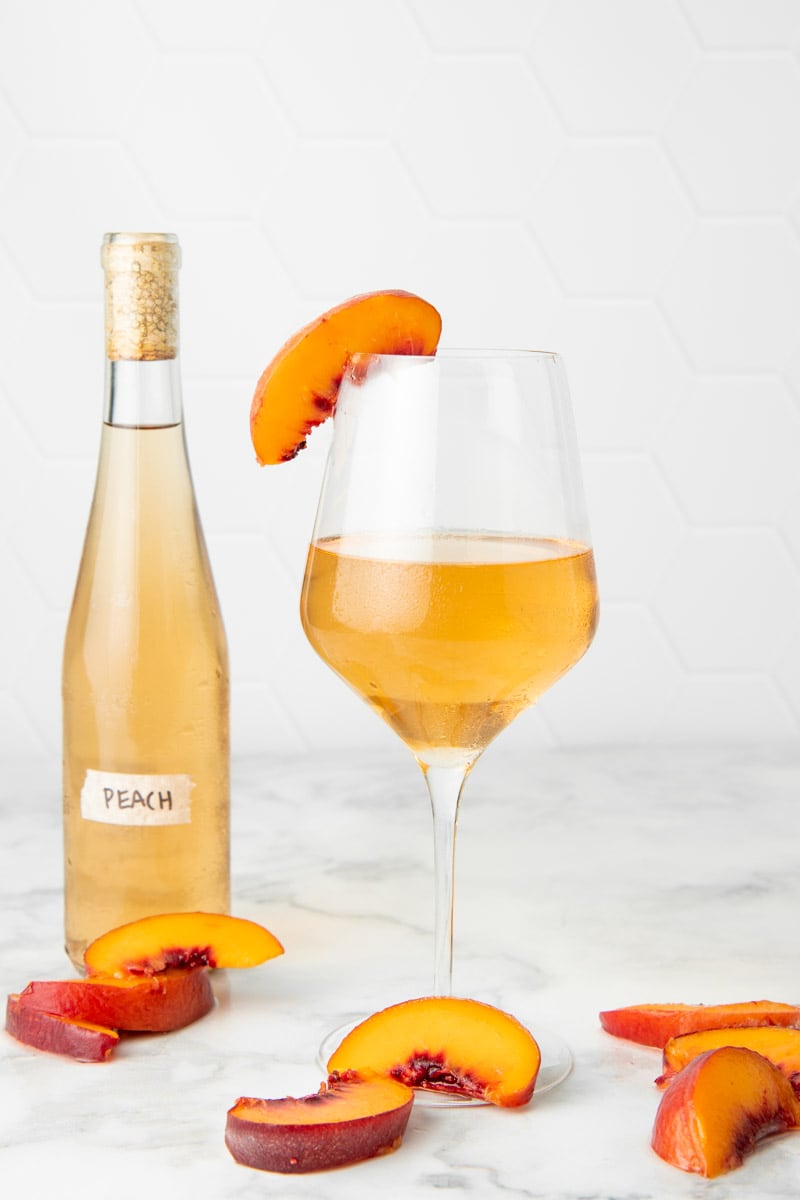
Water
Spring water from the store or filtered water is best—chlorinated tap water can interfere with your yeast!
Yeast
Yeast is what turns the fruit, sugar, and water into wine! Many folks use wild yeast to brew wines—it’s the classic way to make wine—but to keep things easy for beginners, we’re recommending you use purchased winemaker’s yeast. We use Red Star Premier Blanc Yeast for our peach wine.

Wine Additives
Fruit, sugar, yeast and water are all you need to make peach wine, but there are some additives you can use to improve the flavor, fermentation, and appearance of your wine. Here’s what we use in our peach wine:
- Acid: To get a good balanced flavor, it’s nice to add acid to your homemade wine. You can do this using citrus juice—lemons and lemon juice are particularly good with peaches—or you can go for consistency and use a high quality winemaker’s acid blend.
- Pectic Enzyme: If you want a crisp, clear wine, you’ll want to use pectic enzyme in your brew. This helps the wine clear up after fermentation. If a cloudy or hazy wine doesn’t bother you, skip the pectic enzyme!
- Tannin: Tannin adds a bit of astringency to your wine—which can be a good thing for a balanced flavor! You can add tannin by using purchased Wine Tannin or by just adding a cup or two of strongly brewed black tea.
Wholefully Protip
Yeast needs nutrients to thrive, and with some fruit wines (like our blueberry wine), we recommend using yeast nutrient to help along the fermentation. We’ve never needed it with peach wine but if you find your fermentation sluggish, some Yeast Nutrient can reactivate the fermentation and help your wine along.

Can I use frozen peaches?
Absolutely, and frozen peaches will work better than fresh! Even if you just picked your peaches, we recommend freezing them first so that the juice is released more easily.
How many peaches do I need?
Winemaking is more of an art than a science, so you can experiment with this a little bit. In general, you’ll want between 3 to 3 1/2 pounds of peaches for a gallon of peach wine.
How do I make a dry peach wine (or a sweet peach wine)?
The sweetness of your finished wine comes down to both the amount of sugar you add and how much sugar your wine yeast can eat. Different strains of yeast eat different amounts of sugar and live to a higher alcohol content—a yeast that can tolerate a higher alcohol content will typically give you a drier wine.
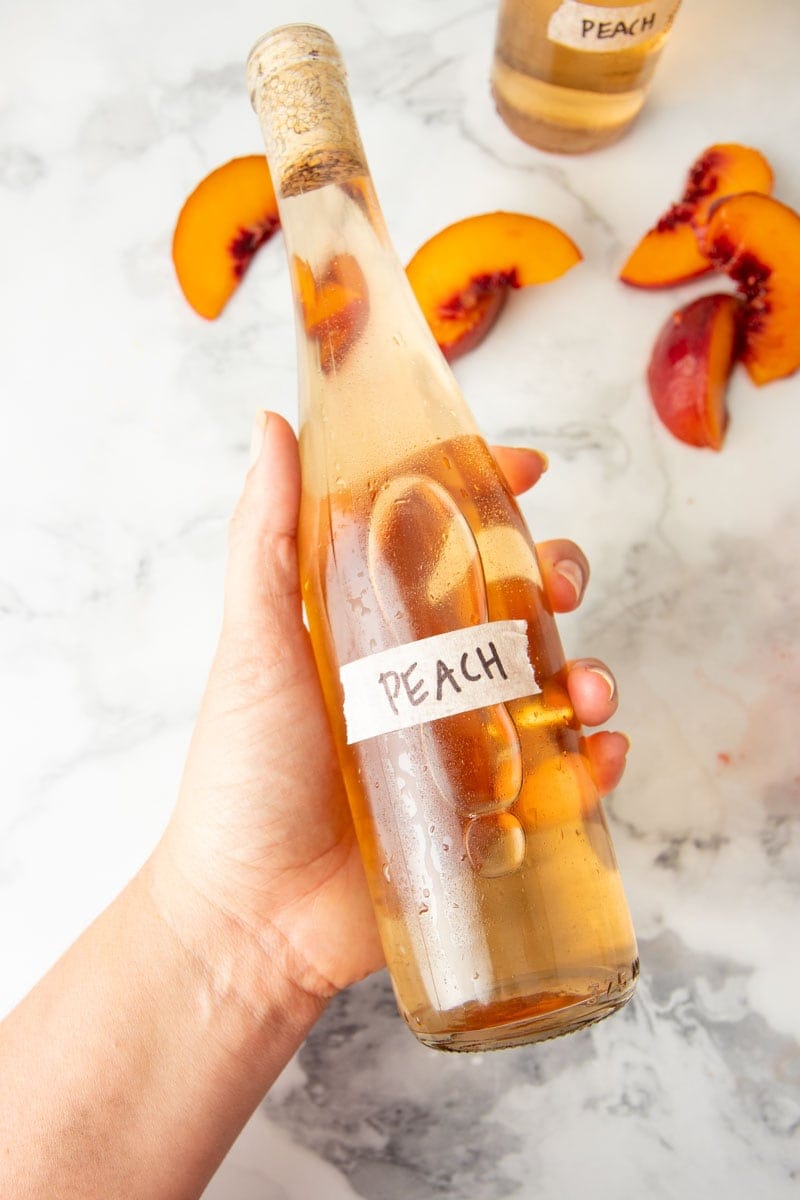
When you are just starting out, I recommend starting with 2-3 pounds of sugar and a yeast that has an average alcohol tolerance. With a 14% alcohol tolerance, Red Star Premier Blanc is a great yeast for a semi-dry wine for beginners, and you can sweeten to taste from there.
For a sweeter wine, add more sugar with the same yeast during the winemaking process, or add a simple syrup just before serving.
For a drier wine, use less sugar with the same yeast during the winemaking process, or choose a yeast with a higher alcohol tolerance.
How do you make homemade peach wine?
For visual learners, we recommend you check out our Strawberry Wine tutorial, where we have laid everything out, step-by-step, with images. But here is the basic how-to for making Peach Wine:
- Sanitize your equipment.
- Make the must by mixing your frozen fruit, sugar, and pectic enzyme in your primary fermentation container. Cover and set aside for up to 24 hours (but at least a few hours).
- When 24 hours is up, mix the wine yeast with non-chlorinated water, and set it aside.
- Stir the selected additives in to the primary fermenter, along with non-chlorinated water and the yeast/water mixture.
- Close up the fermenter and fit it with an airlock filled with water.
- Agitate the wine at least once a day—you can do this by swirling the whole container, or by taking off the lid and giving the wine a good stir.
- Let everything ferment until the air lock has dramatically less bubbling. For us, this tends to happen with peach wine within 7-10 days.
- Strain out the fruit and transfer the wine to your secondary fermentation vessel—typically a clean carboy. Fit it with an airlock and ferment until there are no bubbles left.
- Bottle your wine and let it age.
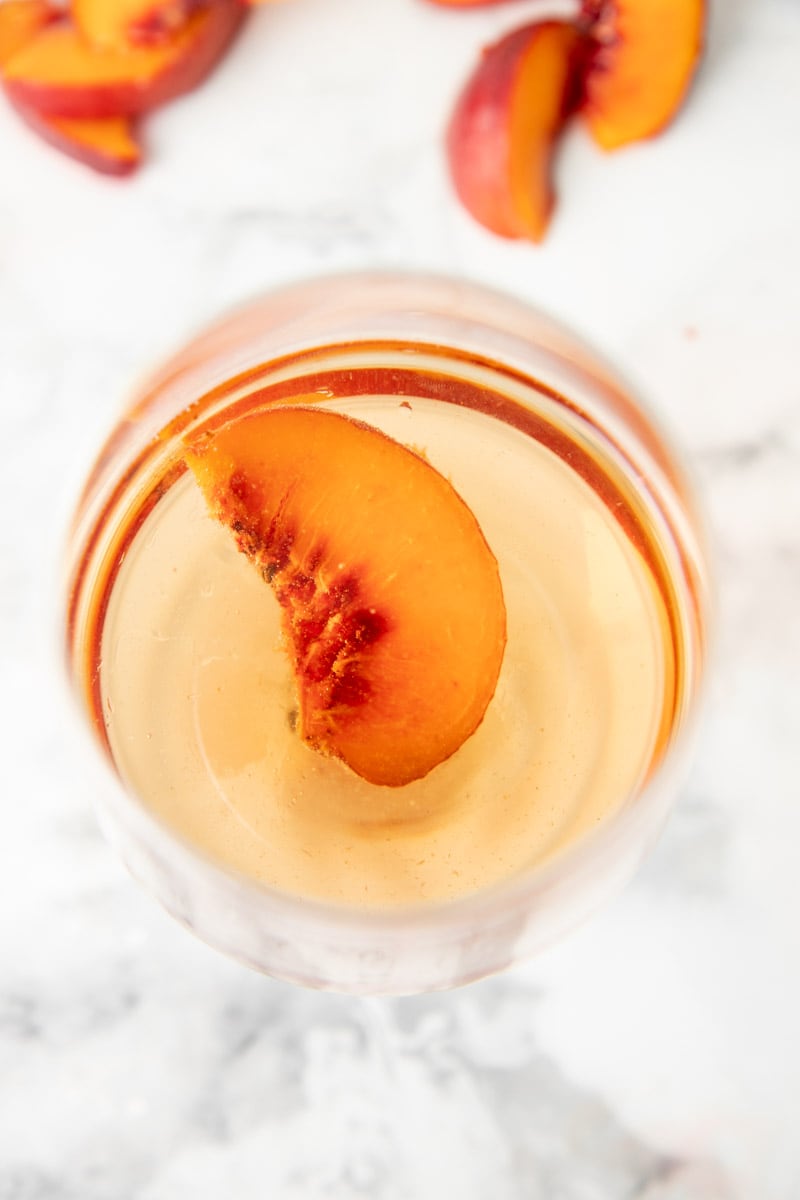
Should I use campden tablets in this wine?
Campden tablets are a frequently used additive in homemade wine that are used to sterilize wine at various stages during the winemaking process. They kill off all the yeast and bacteria.
Many people use them to stop fermentation before it’s complete if they want to achieve a certain level of sweetness. Some people add them to the wine just before bottling to make certain fermentation is over to avoid making bottle bombs.
I personally do not use Campden tablets. Mostly because I just don’t find that I need them in my winemaking process, but also because I enjoy including wild yeasts and bacteria in my creations. There are tons of resources on the internet about using Campden tablets if sterilization is of interest to you.
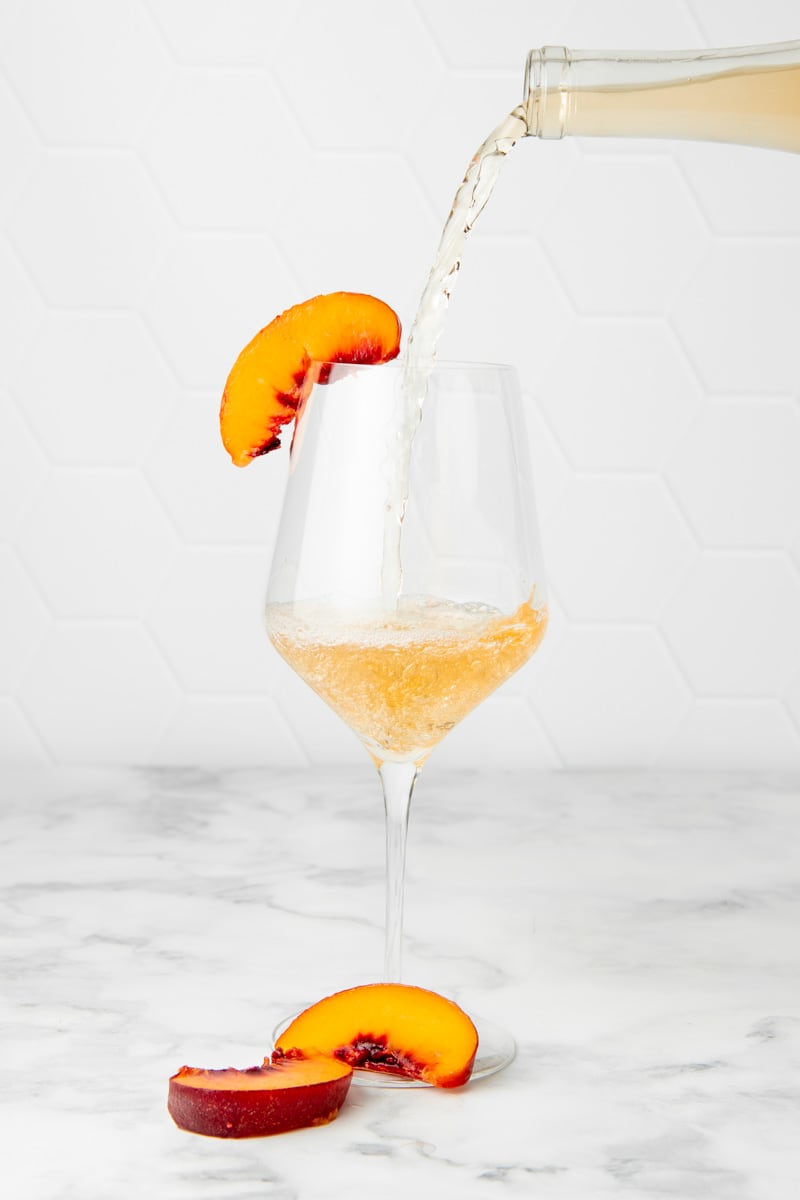
Should peach wine be refrigerated?
In general, if the alcohol content of your wine is below 15%, you should keep it refrigerated. If it is above 15%, you should be able to store it safely at room temperature.
To figure out the alcohol content of your wine, you can measure the specific gravity with a hydrometer, or estimate it by looking at the alcohol tolerance of the yeast you used.
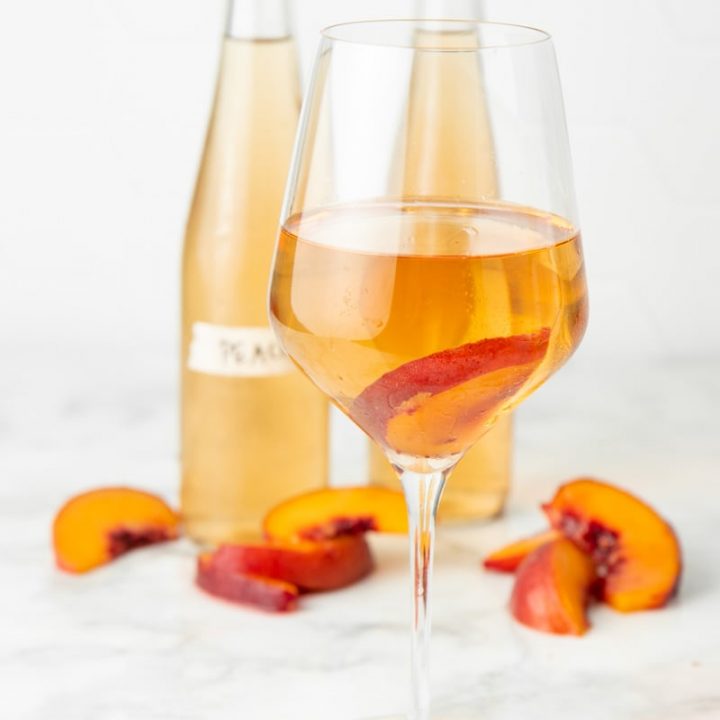
Homemade Peach Wine
Peaches are one of the easiest fruits to use for homemade wine. Follow this peach wine recipe and learn to make peach wine today.
Ingredients
- 3 to 3 1/2 pounds frozen peach slices or chunks (no pits, but keep the skin on)
- 3 pounds cane sugar (this will make a semi-dry wine)
- 1/2 teaspoon pectic enzyme, optional
- Non-chlorinated water
- 1/4 packet Red Star Premier Blanc yeast
- 1 teaspoon acid blend OR 2 tablespoons lemon juice
- 1/8 teaspoon Wine Tannin or 2 cups strongly brewed black tea
Instructions
Before You Start
- Wash all your tools and sterilize to your desired level of cleanliness. Maintain this level of cleanliness throughout the process.
Making the Wine
- In a big bucket, a large jar, or specifically designed fermenter, add the frozen fruit, cane sugar, and pectic enzyme (if using). Cover and let sit out until the peaches are defrosted and the entire mixture is quite juicy—at least four hours, up to 24 hours.
- When the 24 hours is up (or earlier if the fruit has defrosted), combine about a cup of water with the yeast in a small bowl, and set aside to wake up for 10 minutes.
- Add the acid blend or lemon juice, and tannin or black tea to the peach mixture. Add in enough water to bring the total volume of the mixture to about 1 1/3 gallons—no need to be perfectly accurate.
- Pitch the yeast water into the mixture, and stir well to agitate. Close the lid on the fermenter and fit with an airlock.
Primary Fermentation
- Place the fermenter in a spot out of direct light, but where you can keep an eye on it. Agitate the mixture well at least once per day by stirring or swirling.
- The fermentation should start within 1-3 days. Continue to stir or swirl thoroughly throughout the entire primary fermentation stage.
- When the bubbles slow down considerably in the airlock (usually around the 7- to 10-day mark for us with this wine, but it’ll vary based on the heat of your house), your primary fermentation is done.
Secondary Fermentation
- Fit a funnel with a mesh sieve into the neck of a sterilized carboy. You can also use a special brewing funnel with a strainer if you choose.
- Using a large ladle, scoop out the peach pieces and pour them through the sieve and funnel.
- Press the peach pieces into the sieve to get as much of the early wine out as possible.
- When the sieve fills up, dump the spent must into the compost, and replace. Keep repeating until the majority of the fruit is out of the wine.
- Pour the remainder of the wine through the sieve and funnel.
- You want the wine to come to the bottom of the neck of the carboy. If you have too much, you can pour yourself a glass of not-yet-finished-but-still-delicious wine. If you have too little, you can top it off with more non-chlorinated water.
- Fit the carboy with an airlock. All this agitation will restart any sluggish fermentation quite actively, so I recommend placing the carboy in a place where you can keep an eye on it easily (but still out of direct sunlight).
- Once you know it’s not going to geyser wine everywhere, you can then move the carboy to a dark, out-of-the-way spot to do the longer secondary fermentation.
- Secondary fermentation is complete when the wine is “still,” meaning there is no carbonation in the wine, no bubbling in the airlock, and the wine has cleared. This can take anywhere from a couple of weeks to months, depending on a number of factors. Do not bottle until the wine is still.
Bottling and Aging
- Using a siphon, transfer the finished peach wine—leaving behind the sediment—from the carboy to the bottling bucket (or the primary fermenter if it has a spigot).
- Fit the bottling container spigot with a bottle filler, if using.
- Fill clean, sanitized bottles using the bottle filler or just the spigot.
- Cap, cork, or close the top of the bottles. Label the bottles.
- Store in a cool dark spot (if using corks, turn the bottles on their sides to keep the corks wet) and age for at least 30 days, but preferably 6-12 months for the best flavor.
Notes
- If your peach wine tastes too dry after secondary fermentation, you’ll want to back sweeten it using the process outlined in our Strawberry Wine post.
- Make sure to taste your wine throughout the process! Not only is it fun to sample, it also helps you better understand the fermentation process at work.
Nutrition Information:
Yield: 25 Serving Size: 5 ozAmount Per Serving: Calories: 237Total Fat: 0gSaturated Fat: 0gTrans Fat: 0gUnsaturated Fat: 0gCholesterol: 0mgSodium: 1mgCarbohydrates: 61gFiber: 1gSugar: 60gProtein: 1g
At Wholefully, we believe that good nutrition is about much more than just the numbers on the nutrition facts panel. Please use the above information as only a small part of what helps you decide what foods are nourishing for you.

